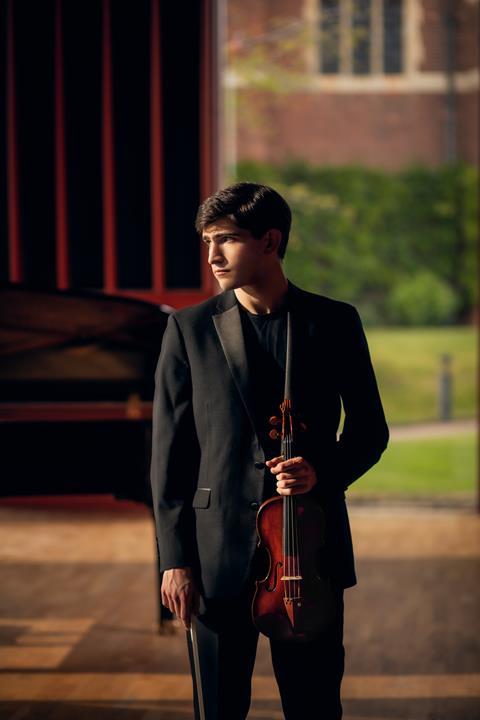The violinist shines a light on works by three pioneering female composers, ahead of a recital at Champs Hill in March

Discover more Featured Stories like this in The Strad Playing Hub
When my friend, John Lenehan, called me to ask if I had played Amy Beach’s Violin Sonata Op. 34, I was very enthusiastic to hear what he had in mind as I had wanted to get to grips with her work for quite a while. John had given Mary Bowerman a recording of the Beach, Dame Ethel Smyth’s Violin Sonata Op. 7 and Clara Schumann’s Three Romances that he and Tasmin Little had recorded so beautifully for Chandos in 2019, and Mary was so moved by the recording that she wanted to bring the repertoire in its entirety to Champs Hill. Of course, John and I were happy to oblige! Tasmin has continued to be such a supportive mentor to me since my time working with her at the Royal Academy of Music, so I’m very happy she is involved in this project.
Review: Tasmin Little; John Lenehan: Clara Schumann, Ethel Smyth, Amy Beach
Read: Tasmin Little: why I love the music of Ethel Smyth, Clara Schumann and Amy Beach
The sonatas of Amy Beach and Ethel Smyth are similar in structure. Both are written with four movements, each with a second movement ‘scherzo’ and a slow third, however their style couldn’t be further apart! From my first reading of the Beach, I knew it would be something of an emotional and physical endurance test. It is heart on sleeve romanticism with a very symphonic piano part, often stylistically reminiscent of Rachmaninoff’s keyboard writing, and enormous stamina is needed to match the huge forces of the piano. By contrast, I found the texture of Smyth’s writing much thinner. Harmonically it is unusual to say the least; wandering tonalities right from the start, creating a dark and somewhat ominous mood, need careful navigation and it gives a restless feel to the opening movement. Each sonata’s second movement ‘scherzo’ are both lighter in feel, with playful runs and passages that bring a certain charm to each sonata.
Finding pockets of space and corners to take time in a quicker tempo can prove challenging, and extreme dynamics and precise articulation can’t ever be over-exaggerated and need to be strictly observed to emphasise each movement’s cheeky character. In both sonatas, the slow third movements are what I found most demanding, particularly the Beach. It requires careful and well thought through phrase structures and shaping, and the long, lineal melodic violin writing really stretches us to bring out the most beautiful singing qualities of our instrument.
Beach’s two shorter works are true gems! TheInvocation Op. 55 is a wonderful discovery for me - I now consider it among my favourite violin miniatures and know I will include it in my future programmes. Its heart-warming melody is so satisfying to play, and one shouldn’t be shy with the use of portamenti and varying speeds of vibrato. It is music that I can hear the ‘old school’ violinists, Fritz Kreisler or Mischa Elman, playing so perfectly; the tradition of playing that I remain so fond of. TheRomance Op. 23 is more substantial and takes us through every emotion of a ‘romance’. From the opening gentle melodies, to drama with dynamic rhythmic contrasts in the middle section and lastly sheer passion where the violin plays at the top realms of its range on the E string, it is equally enjoyable to perform.
The Three Romances by Clara Schumann (who incidentally knew Ethel Smyth when a young Smyth went to study in Leipzig) are all quite different in style, yet in my opinion each give the feeling that they were composed as though music flowed from her mind to pen without obstacle. As such, I think they should be played with freedom and spontaneity to give the impression that we are improvising as we play (an effect that can often be the most difficult to achieve!) The first piece is perhaps the most true to form of a typical ‘romance’. The second is more wandering in feel and in the third, one can hear Robert’s influence strongest; long melodic lines with which I always remind myself to control vibrato on every note and to maintain smooth legatos in the right arm, enabling the violin to sing constantly.
From the outset, learning a brand new concert programme among my other projects was always going to be the biggest challenge itself, yet one that I knew would reap the greatest rewards. It has allowed me to delve into repertoire that I had hardly any previous knowledge of and that I could approach with totally fresh ears and eyes - not something performing musicians get to experience all too frequently. I am delighted to explore these great works with such a sensitive musical partner in John Lenehan, and am sure they will remain in the literature of established repertoire for many years to come.
Cristian Grajner de Sá and John Lenehan will perform at Champs Hill on 10 March 2023
Watch: Violinist Cristian de Sá performs Ravel’s Tzigane
Read: Ethel Smyth: life as a suffragette and composer
Read: Forgotten in HIStory: shining a light on female composers through the ages
Read more Featured Stories like this in The Strad Playing Hub












































No comments yet